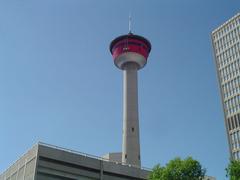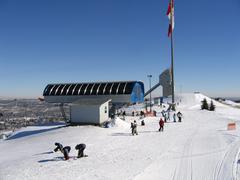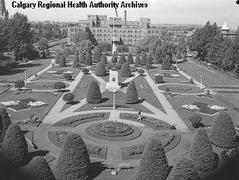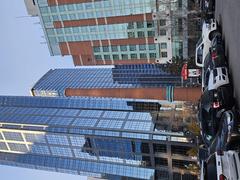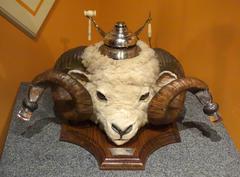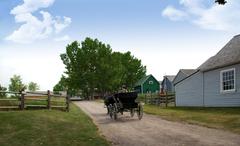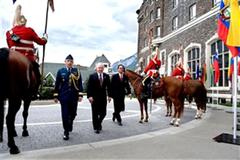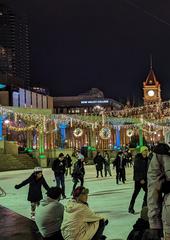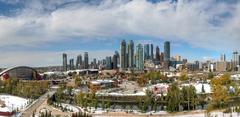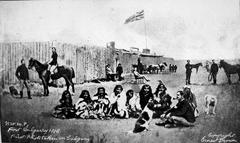
Nose Hill Park Calgary: Visiting Hours, Tickets, and Historical Sites Guide
Date: 03/07/2025
Introduction
Nose Hill Park is a natural and cultural landmark nestled in northwest Calgary, Alberta. Spanning over 11 square kilometers, it stands as one of North America’s largest urban parks. Characterized by expansive native fescue grasslands, panoramic city and mountain views, and a wealth of Indigenous heritage, Nose Hill Park invites visitors to explore its trails, archaeological sites, and scenic vistas. This comprehensive guide provides all essential details on park history, significance, visiting hours, accessibility, amenities, and travel tips to ensure a memorable visit.
For more detailed information, visit the City of Calgary’s Nose Hill Park page, the Friends of Nose Hill Society, and Alberta Historic Places.
Contents
- Indigenous Presence and Archaeological Heritage
- Early European Encounters and Settlement
- Urban Development and Conservation
- Ecological and Cultural Significance
- Visitor Information
- Visiting Hours & Tickets
- Accessibility & Getting There
- Facilities and Amenities
- Nearby Attractions
- Visuals and Media Recommendations
- FAQ
- Conclusion & Call to Action
- References
Indigenous Presence and Archaeological Heritage
Nose Hill Park is a living testament to thousands of years of Indigenous occupation and significance. Over 40 pre-contact archaeological sites have been identified within the park, including tipi rings, kill sites, lithic scatters, and a prominent medicine wheel—remarkable for its ceremonial and astronomical importance (Alberta Historic Places). The Blackfoot Confederacy and other Treaty 7 Nations have used this land for hunting, ceremonies, and seasonal camps (Native Tribes Info). The hill’s elevation provided strategic vantage points for observing bison herds and communicating across the plains, as evidenced by archaeological finds such as ancient tool-making stations and a bison bone bed (Liquisearch).
Visitors are encouraged to honor and respect these sacred sites, which remain focal points for cultural education and reconciliation.
Early European Encounters and Settlement
The first documented European to ascend Nose Hill was Hudson’s Bay Company trader Peter Fidler in December 1779, guided by Peigan First Nation members. Explorers such as David Thompson also referenced the hill in their journals, noting the unique climate and landscape (Liquisearch). The late 19th century saw the disappearance of bison from the area, profoundly affecting Indigenous life and marking a transition to European settlement and resource use.
Urban Development and Conservation
With the founding of Fort Calgary and rapid urban expansion, Nose Hill was used for cattle grazing, agriculture, and sandstone quarrying for many of Calgary’s historic buildings (Alberta Historic Places). In the 1960s and 1970s, development pressures threatened the hill’s natural character, prompting grassroots advocacy. The Calgary Local Council of Women and community associations led efforts to preserve the park, culminating in a successful campaign that established Nose Hill Park as protected municipal land by the late 1980s (Friends of Nose Hill Society).
Ecological and Cultural Significance
Nose Hill Park is one of the last remaining large tracts of native fescue grassland in Alberta (City of Calgary). The park’s diverse habitats support over 150 vertebrate species, including deer, coyotes, hawks, and songbirds. Four distinct forest plant communities and rare grassland flora are found here (Nose Hill Park Biophysical Impact Assessment). The park’s coulees, glacial erratics, and elevated terrain reflect an ancient geological history shaped by ice sheets and glacial lakes.
Interpretive signage throughout the park highlights its archaeological and ecological significance, offering visitors insight into both natural and cultural narratives.
Visitor Information
Visiting Hours & Tickets
- Hours: Open daily from 5 AM to 11 PM (some sources note 24/7 access; check City of Calgary for updates).
- Tickets/Fees: Free entry; no tickets required.
Accessibility & Getting There
- Multiple entrances provide access from John Laurie Boulevard NW, 14th Street NW, Shaganappi Trail, and surrounding communities.
- Free parking lots are available at key access points.
- Calgary Transit serves neighborhoods near the park; check current bus schedules.
- Some paved trails are accessible for wheelchairs and strollers, but much of the terrain is natural and may be challenging.
Facilities and Amenities
- Basic amenities: restrooms at select parking lots, benches, picnic tables, and interpretive signage.
- No commercial services; bring water and snacks.
- Designated large off-leash areas for dogs (must be under control).
- Limited garbage bins—pack out your trash.
Nearby Attractions
- Visit Fort Calgary, Heritage Park Historical Village, Calgary Zoo, and Telus Spark Science Centre for additional historical and family-friendly experiences.
Visuals and Media Recommendations
Enhance your visit with virtual tours and high-quality photographs available from the City of Calgary’s Nose Hill Park page and Friends of Nose Hill Society. Suggested images include panoramic hilltop views, tipi rings, and native wildlife. Use descriptive alt text such as “Nose Hill Park visiting hours,” “Calgary historical sites,” and “Nose Hill Park tickets” for accessibility and SEO.
Frequently Asked Questions (FAQ)
Q: What are Nose Hill Park’s visiting hours?
A: Open daily from 5 AM to 11 PM. Some sources note 24/7 access; confirm before visiting.
Q: Is there an entrance fee or are tickets required?
A: No, the park is free to enter.
Q: Are there guided tours?
A: No regular guided tours, but community organizations like Friends of Nose Hill occasionally offer educational walks. Check their website for events.
Q: Is the park wheelchair accessible?
A: Select paved trails and parking areas are accessible; most trails are natural surface and may be uneven.
Q: Can I bring my dog?
A: Yes, dogs are allowed and permitted off-leash in designated areas.
Q: What wildlife can I see?
A: Deer, coyotes, rabbits, ground squirrels, and various bird species are commonly seen.
Conclusion & Call to Action
Nose Hill Park offers a unique blend of natural beauty, Indigenous heritage, and recreational opportunity within Calgary’s urban landscape. Whether you’re hiking, birdwatching, exploring archaeological sites, or simply seeking a peaceful escape, Nose Hill Park delivers a memorable experience for all ages.
Plan your visit today:
- Download the Audiala app for interactive maps and trail guides.
- Follow the Friends of Nose Hill Society and City of Calgary for updates on events and stewardship opportunities.
- Respect park rules, wildlife habitats, and cultural sites during your visit.
- Share your experiences and help preserve this remarkable landscape for future generations.
References and Official Links
- Alberta Historic Places: Nose Hill Park
- City of Calgary: Archaeology and Calgary Parks
- Hike Bike Travel: Nose Hill Park Guide
- City of Calgary: Nose Hill Park
- Friends of Nose Hill Society: History
- Native Tribes Info: Medicine Wheel Nose Hill Park Calgary
- CBC News: Calgary Nose Hill Archaeology Blackfoot

